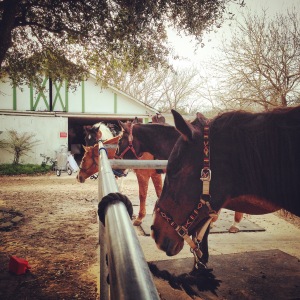It’s a question I often ask my students: Where are you going?
New riders often don’t realize that they have to ride their horses the whole time they’re in the saddle. There’s no point during the lesson at which they can just sit there. They have to keep a feel of their horse, anticipate the horse’s next moves, and always have in their mind where they want to go and what they want the horse to do. (This is a concept that is illustrated nicely in this video by Carson James.)
If they don’t, the horse will decide for them.
And that decision will probably not be to the rider’s liking.
I’m starting to realize that this is a pretty apt metaphor for life. You can passively let it take you where it wants to go. Or you can decide what you want out of it and use all your tools to get there.
I spent a very long time searching for what I wanted out of life. But the only reason it took me so long was that I knew the whole time what I wanted, and I wasn’t pursuing it because I didn’t think it was a valid option. For nearly ten years I constantly changed apartments, changed jobs, I tried new exercise regimens, explored new hobbies, and none of it ever satisfied me.
Then, nearly five years ago, I finally found my way back to horses. Since then, I’ve chronicled my journey from being a 30-year-old starting over and trying to regain the muscles needed to ride well again while taking one lesson a week in insane conditions in the middle of New York City, to leasing a horse in Texas, riding four times a week and learning an entirely new discipline, just starting to show again at the lowest level at the age of 35.
When I started out, I had no idea where this was going. I just knew I wanted to ride again. That my body and my mind and my heart missed it and it was time to do whatever it took to fill that hole in my life. I was just glad to be sitting on the horse; the direction didn’t matter.
As I got more involved, I started to realize that it wasn’t just filling the hole of a missed hobby. It was actually something that could stop the emptiness left by not having a career that engaged or fulfilled me. It was something that I could throw myself into wholeheartedly and never get bored learning more about. It was something I could aspire to mastering, and which I would feel proud of myself once I did.
I started to dream about working with horses. I learned about training programs for wild mustangs, and that opened up the whole world of understanding how to relate to these animals on their own terms, to studying ethology, to learning about conservation efforts, and ranching, and all the riding disciplines associated with that, and a million other fascinating things that had always been at the heart of me, ever since I was a tiny girl telling my parents that I wanted to be a cowgirl when I grew up.
So many different threads have come together to bring me to this point. Frustrated at my inability to find English jumping lessons in the area, I reached out to a trainer and asked her if she thought someone with my background would benefit from Western lessons. I figured if I couldn’t find what I was looking for, maybe I should look at what was right there in front of me. That resulted in the trainer offering to lease Dunnie to me. It brought me the closest working relationship I’ve ever had with a horse. It also brought me a mentor relationship and friendship with that trainer that I’d been looking for my whole life. It brought me back to teaching riding again, finally for the first time since I was 16 years old getting paid to work with horses.
So here I am. I’ve got a great horse underneath me (both literally and metaphorically), and it’s for me to decide in what direction to travel — and then to use everything I’ve got in my toolbox to get myself there.
That’s what I’m working on now. I’m researching different fields of horse work, I’m reading up on them, and I’m finding out how to get trained and certified. Look for some big changes coming around here, including the launch of a new site in the not-too-distant-future. Urban Equestrian has been a wonderful place to reflect on what I’ve been learning on my journey back to being a horsewoman, but now it’s time for action.







